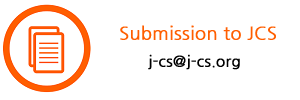You may find the submission format on “NOTICE&FAQ”
Language
All submissions must be in English
Submission of manuscripts
A. Initial submission
Only original articles will be considered for publication in the Journal of Cognitive Science. Articles submitted for initial consideration should be less than 10,000 words, and accompanied by an abstract with keywords.
Authors should send an electronic copy (MS Word) to JCS – Hard copies should be sent to the following address:
(Prof) Chungmin Lee Editor-in-Chief Journal of Cognitive Science Research Building for Professors Emeriti Office #308, 150-dong Seoul National University Seoul, 151-742 Republic of Korea
– All electronic submissions should be sent to  .
.
Contributions may be in the form of articles, brief reports, or literature reviews.
B. Review process
All published articles in the Journal of Cognitive Science will have undergone a rigorous process of peer review. This is based on an initial stage of editor screening, followed by anonymous refereeing by two to three international independent reviewers with high expertise in relevant fields, and then a final review by the main editors, and editor-in-chief.
A final decision on the article will normally be communicated to the author within four months or more. If accepted for publication, reviews will be forwarded to the corresponding author, who will then have an opportunity to make revisions if warranted.
C. Post review process
Once the article has been accepted for publication, it is the responsibility of the author to ensure that the article conforms to Cognitive Science style guidelines (see below), and resubmitted within one week, in the required format (see below).
Style and Format
Whole manuscript
Electronic text should be sent as text or MS Word format; MS Word is preferred, but RTF is also optional.
The manuscript should be the final version that you wish to be sent for peer review. Do not submit partial versions or incomplete drafts, unless we specifically request that you do so.
Abstract
Provide a concise (< 400 word) abstract and several keywords.
Headings and subheadings
Cognitive Science accepts a maximum of three levels of headings and subheadings.
All titles must use complete expanded words and no acronyms.
Footnotes
Use footnotes sparingly and make every effort to include necessary information in the main body of text.
Citing works
The list of cited works substantiates work in the main text. Refer to the following guidelines.
Asian names should be specified in full
For journal articles with more than five authors per paper, list the first five author names followed by et al. For each author listed, supply all initials and last name.
If authors desire to add a Digital Object Identifier (DOI), this can assist in locating the object, even if moved to another URL (cf, www.doi.org). This is optional, but if included, should, include all DOI information relevant to cited works in the list. (When using Endnote, employ relevant styles to this outline.)
Format the reference list in accordance with the JCS style (see examples below).
Whole Book references
Leakey, R., & Lewin, R. 1992. Origins Reconsidered: In Search of What Makes us Human. New York: Doubleday.
Chapter references in books
O'Sullivan, C., & Yeager, C. P. 1989. Communicative context and linguistic competence: The effect of social setting on a chimpanzee's conversational skill. In R. A. Gardner, B. T. Gardner, & T. E. Van Cantfort (Eds.), Teaching Sign Language to Chimpanzees, 269-279. Albany: SUNY Press.
Article references
Lee, Chungmin 1975. Embedded performatives. Language 51, 105-108.
Website references
Harris, K., A. 2005b. Same activity, different learning. Focus on Basics:Connecting Research and Practice. Boston, MA: NCSALL. Retrieved on December 2005, from the website: http://www.ncsall.net.
Passages, tables, or figures in print references
Leakey, R., & Lewin, R. 1992. Origins Reconsidered: In Search of What Makes us Human. New York: Doubleday, 201.
Preparing figure, table, and graph items
Figures, tables, and graphs must be submitted simultaneously with your text in the correct format.
Cite all items within the main body of the text.
For figures, center the figure number and caption below the figure. For tables, left-justify the table number above table.
Line weights
0.5 to 0.75 point should be used as basic line weight for drawing, with heavier or lighter line weights for emphasis and clarity as follows:
Graph axes: 0.5 point
Graph borders: 0.75 point.
Subsection headings in capitals and bold font
All sections and subsections of the article should be numbered using Arabic numerals and decimals and left-justified as follows:
The first line of the text following any section or subsection title should be left-justified and double-spaced from any title.

